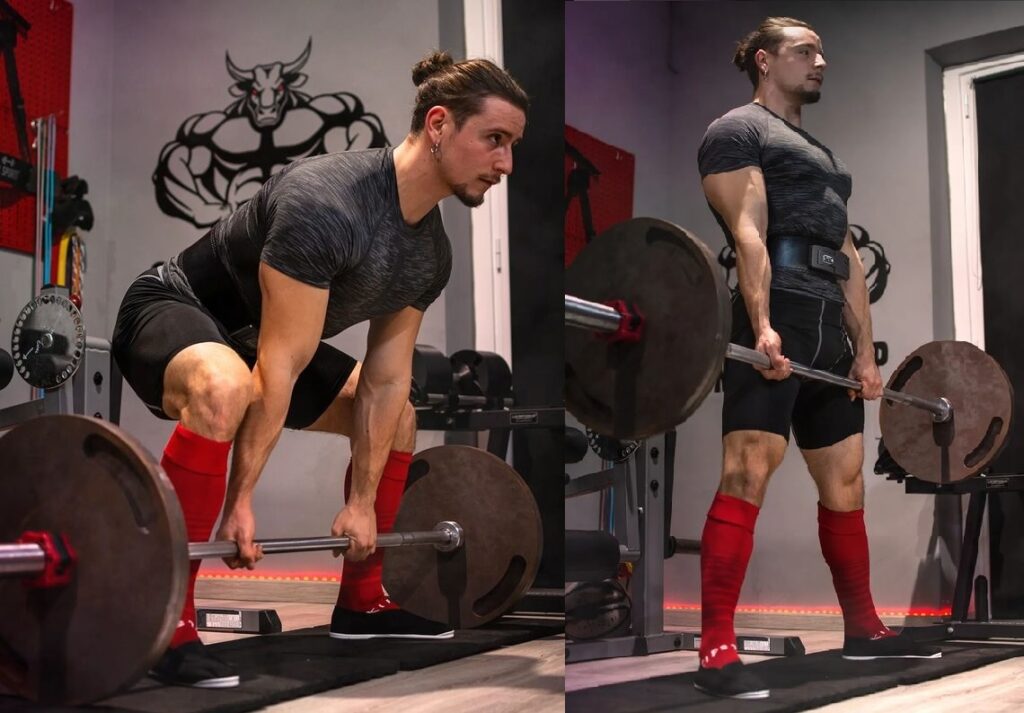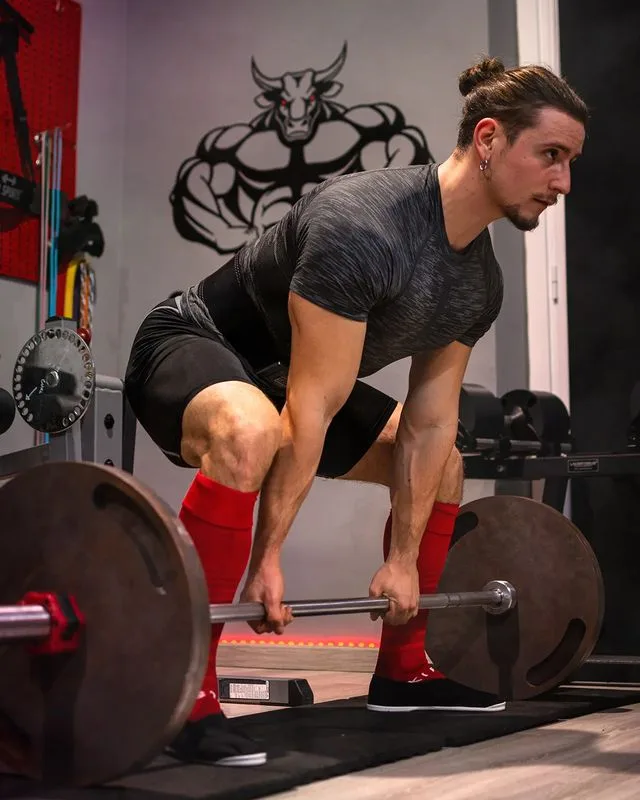The sumo deadlift, a variation of the deadlift, uses a wide stance (1.5 to 2 times the width of your shoulders) to shorten the range of motion and limit the shearing force on the lower back. 1
This may feel more comfortable in the hips than traditional deadlifts, depending on your biomechanics (if you tend to walk with your toes pointed up, sumo may be a better fit for you).
The downside of the sumo deadlift is the reduced range of motion, which results in less work done, which means less overall muscle development. 2
Still, if you lack the flexibility to perform traditional deadlifts, if it just feels uncomfortable (some people’s bodies are better suited for sumo deadlifts), or if it’s causing lower back pain. , then try this variation. 3
How to do sumo deadlift properly?
As an alternative to the standard deadlift, the sumo deadlifts come with its own technique. The sumo deadlifts demands more of the hip flexibility and isn’t as customizable as other pulling movements, which means you have plenty of room to make mistakes. So, with that out of the way, let’s learn how to do the sumo deadlift properly so that you don’t make any mistakes when doing it.
Sumo deadlift setup and movement

Step 1: Stand more than shoulder width apart
- Always start with the bar on the floor—not the safety pins or rack.
- Stand with your feet wider than shoulder-width apart, and your toes pointing out at a 45° angle instead of straight forward.
- Generally speaking, the longer your legs, the bigger your toes will be.
- Puff out your chest, and take a deep breath of air into your diaphragm (not your lungs), clenching your stomach as if you’re about to get punched in the stomach.
Step-2: Bend to lower the hips
- Thrust your hips down and grab the bar.
- Whatever grip you typically use for deadlifts, whether it’s an overhand or mixed grip, one underhand and one overhand.
- When you grasp the barbell, your shins should be perpendicular to the floor, your chest should be up and your back should be flat.
- When you’re just starting out, you may find it uncomfortable to open enough to set your hips properly.
- Don’t lift the lower back, and don’t squeeze your shoulder blades together like in a squat. Just lift the chest and shoulders up and lower the back.
- Be patient with your form, you will naturally adjust to the posture over time.
Step-3: Arm straight and closed
- With the arms completely straight and locked out, tighten your core, back, legs and butt to create a feeling of tension throughout the body.
- Once you find your tension, take a full breath into your belly.
- Pull up slightly on the bar and press your feet into the floor to engage your quads.
- Keep elbows locked in place and lower back slightly arched (no rounding!).
- Make sure the hips and shoulders lift together: Don’t lift the hips without lifting the shoulders.
- Keep the back neutral and tight all the way up, and try to keep the bar as straight as possible; There should be a slight lateral movement of the bar as you lift it up.
- Before each stretch, imagine pressure rising in the body, all muscles engaged and ready to fire at once.
Step 4: Lower the weight back down to the floor in a controlled manner
- Once you’ve “found your feet” and established a strong core brace, break the barbell off the floor by pushing down with your feet.
- The beginning of the sumo deadlift is all about your quads – don’t prematurely lift your pelvis in an effort to lower the weight.
- Drive through your heels and extend your knees and hips to lift the bar to mid-thigh height.
- Keep your chest up and, as you pull up, make sure the bar is against your shins to prevent it from moving too far.
Step-5: First lower the bar by pushing the hips back
- You begin to lower the bar by first pushing your hips back, sliding your thighs down in a straight line until the bar reaches your knees.
- The back remains locked in its tight, neutral position the entire time.
- Carefully lower the bar back to the ground, taking care not to round your back.
- Don’t try to intentionally lower the weight, especially as you lower the bar down to your knees. The entire second half of your lift should take about 1-2 seconds.
Step-6: Next Rep—Tap-and-Go and Stop-and-Go Methods
- There are two ways to transition into your next rep: the tap-and-go and stop-and-go methods.
- In the tap-and-go method, you tap the floor with the plates and go straight into your next rep.
- With the stop-and-go method, completely release the plates to the floor for one second before you begin your next rep.
- The latter is harder than the former, but not necessarily better. It’s a matter of finding what feels best for you.
- You may prefer the tap-and-go method, but sometimes you can use the stop-and-go method if you’re going especially heavy.
Sumo deadlift tips
- A sumo deadlift requires highly mobile hips. Most of your leverage in the sumo bridge comes from the setup itself – if you can’t externally rotate your thighs, your hips won’t be in optimal position for the pull.
- Trying to do sumo deadlifts with stiff hips is not productive.
- If you’re going to take the time to do sumo pull-ups, make sure you’re agile.
- Where traditional deadlifts are often faster from the floor and harder to lockout, you may find the opposite true in sumo pulls.
- Extreme posture can make it difficult to break inertia and move the bar initially.
- To compensate, many athletes lift their hips up in an effort to lift off their back.
- Make sure you have lowered your hips enough to the starting position.
- A common mistake people make is to start climbing slowly, which makes it all too easy to get stuck.
- This defeats the purpose of drawing the sumo. If you find the bar fighting you in the beginning, be patient with it and continue to drive with your feet. It will do.
- Do not strain to look up while deadlifting, keep the head in a neutral position and the spine in a straight line.
Bottom line
The sumo deadlift is a classic exercise that trains almost your entire body, not much as a conventional deadlift, and is a competitive event in the powerlifting.
It requires great core stability and control, and you should strive to keep the spine straight (neutral) during your entire lift. It’s a good idea to experiment with different foot placements to determine which lifting technique best suits your body.
The sumo deadlift is a variant of the deadlift, but the most common deadlift variation is standing with very narrow foot spacing and gripping the bar with your arms just outside your knees.
- Escamilla RF, Lowry TM, Osbahr DC, Speer KP. Biomechanical analysis of the deadlift during the 1999 Special Olympics World Games. Med Sci Sports Exerc. 2001 Aug;33(8):1345-53. doi: 10.1097/00005768-200108000-00016. PMID: 11474337.[↩]
- Colado JC, Pablos C, Chulvi-Medrano I, Garcia-Masso X, Flandez J, Behm DG. The progression of paraspinal muscle recruitment intensity in localized and global strength training exercises is not based on instability alone. Arch Phys Med Rehabil. 2011 Nov;92(11):1875-83. doi: 10.1016/j.apmr.2011.05.015. PMID: 22032222.[↩]
- Source: Bigger Leaner Stronger: The Simple Science of Building the Ultimate Male Body. By Michael Matthews. Available here: https://amzn.to/3S7dyYD[↩]















